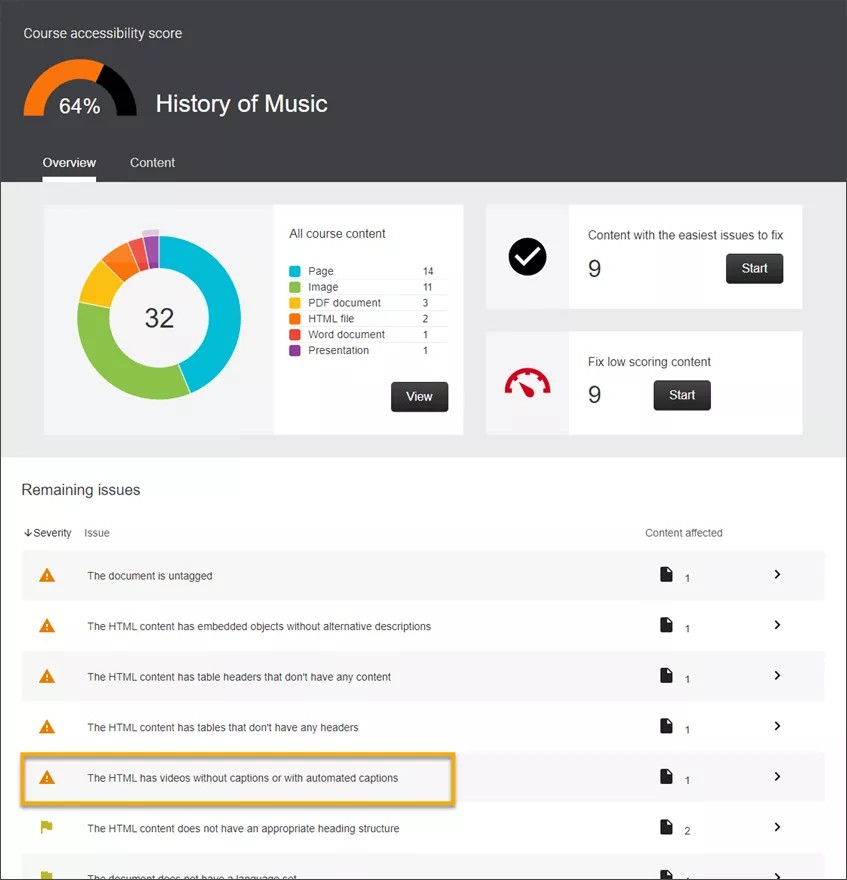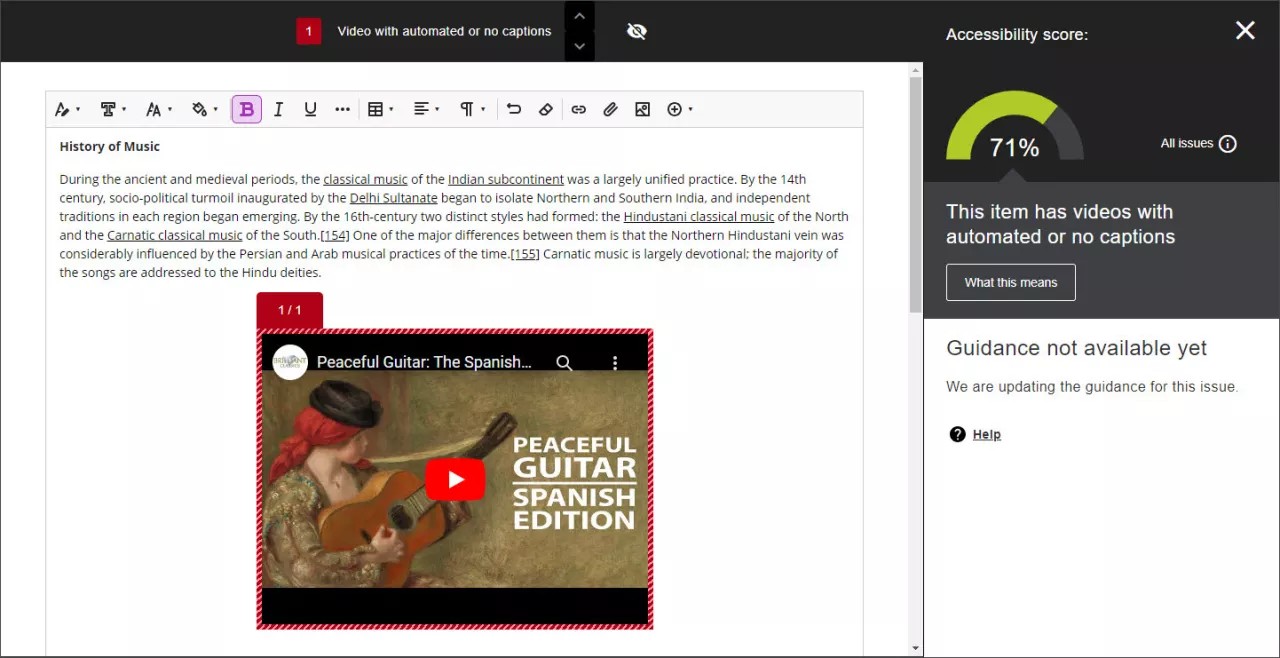Caption checks for videos
As video content continues to be used in new ways on the pathway to creating engaging online course experiences, the importance of providing captions as part of a more inclusive strategy also increases as more students interact with this type of content. Ally is focused on helping instructors create more inclusive learning environments that include this video content by checking and flagging videos without captions as part of the Instructor Feedback.
<>How does Ally flag videos without captions or that include automated captions?
When checking HTML and WYSIWYG content, Ally identifies included videos without captions and videos with automatically generated captions. Instructors can see this represented in the Instructor feedback for each content item, or they can use the Course Accessibility Report to see all of the content items containing videos without captions in their course.
When an instructor accesses the Ally instructor feedback on WYSIWYG content, Ally will highlight videos that are identified with no captions, or where captions have been generated automatically.
Currently videos without captions or those containing auto captions will not change the accessibility score. Because it is likely that instructors are not authoring the video and may not be able to add captions, Ally flags and highlights these videos for awareness purposes without affecting the file accessibility score where the video is added.
Where can Ally identify videos without captions?
Ally’s video caption check is available for the following supported video sources and content types depending on your LMS:
| YouTube | Vimeo | HTML5 Video | ||||
|---|---|---|---|---|---|---|
| Content Type/LMS | Uploaded HTML Files | WYSIWYG | Uploaded HTML Files | WYSIWYG | Uploaded HTML Files | WYSIWYG |
| Blackboard Learn Original | Yes | Yes | Yes | Yes | Yes | Yes |
| Blackboard Learn Ultra | Yes | Yes | Yes | Yes | Yes | No |
| Canvas | Yes | Yes | Yes | Yes | Yes | Yes |
| D2L Brightspace | Yes | Yes | Yes | Yes | Yes | No |
| Moodle | Yes | Yes | Yes | Yes | Yes | No |
For YouTube and HTML 5 videos, you do not need to change any configuration within the Ally Configuration settings. However, it is important to note that if you want to enable caption checks for Vimeo (both public and private videos) you will need to integrate Ally with a Vimeo account. Go to the next section to learn how to configure your Vimeo account.
Opting in and configuring Vimeo
Vimeo leverages OAuth to facilitate the connection to your Ally configuration. The instructions below will help you finish this process.
Before you start
- This feature requires you to Opt-in and configure specific settings within the Ally Configuration tool. To integrate Vimeo with Ally you need to have a Vimeo account and administrator role credentials.
- IMPORTANT: Configuring Ally to check public and private Vimeo videos will result in Ally API calls counting towards your institution’s Vimeo account and rate limits. Ally checks for Vimeo videos may be limited by the request limit per minute that is built into your Vimeo license plan. For more information about Vimeo rate limits, consult How to Work with Rate Limits in Vimeo.
Permissions needed from Vimeo account
Ally requires permission to assess your video content stored on Vimeo, including the following permissions:
- Access to your private videos, showcases, groups, channels, and portfolios.
- Access to your public videos, showcases, groups, channels, and portfolios.
Ally does not store any login information or personal information from your Vimeo account.
Integrate with your Vimeo account
To integrate Ally with Vimeo, you need to grant permission to use your Vimeo account, so Ally is able to assess video content. These are the configuration steps:
- Access the Ally Configuration. (See how to access the Ally Configuration in your LMS.)
- Select the Vimeo configuration tab.
- Select Configure Vimeo Account.
- Ally opens a new tab redirecting to the Vimeo sign-in option.
- Sign in using your Vimeo administrator credentials.
- Select Allow.
- You will see a message warning that the authorization process is in progress. When it is done, you can verify that the configuration is successful in the Vimeo configuration tab.
Ally only supports integration with one Vimeo account. If videos are set as unlisted within your Vimeo privacy settings, Ally will not be able to pick up on those videos as part of its checking.
Disconnect your Vimeo account
If you want to disconnect your Vimeo account from the Ally integration, you can follow these steps:
- Access the Ally Configuration. See how to access the Ally Configuration in your LMS.
- Select the Vimeo configuration tab.
- Select Disconnect Vimeo Account.
- Ally displays a confirmation message.
- Select Disconnect.


